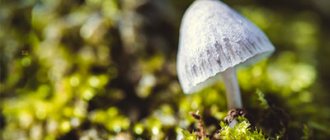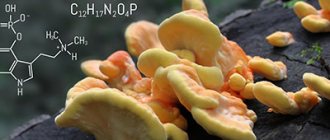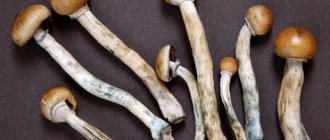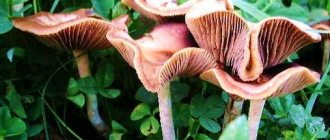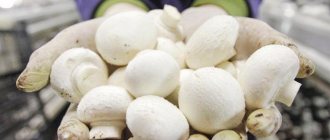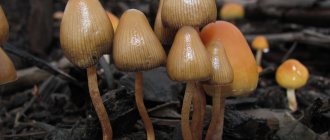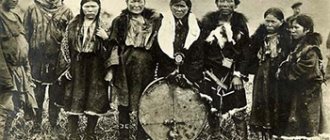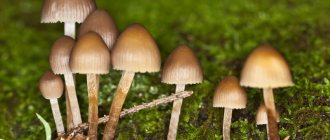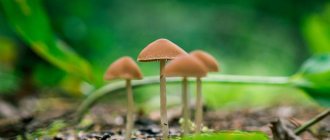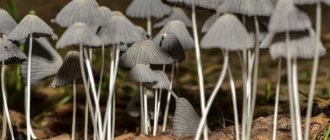Glucogenic or psilocybin mushroom is both a gift from nature and its evil mockery of man, his weaknesses and naive thirst for superpower. Has many types. Psilocybes are common on almost all continents except Antarctica. In order to assess their danger, you should find out what hallucinogenic mushrooms are, what types are found in nature, and the effect of each of them on the human body when consumed. It is necessary to pay attention to the effect on vital organs and learn how psilocybes are used in medicine, as well as their beneficial properties and dangers.
What are psilocybes
These mushrooms have hallucinogenic properties, which is why they are also called magic mushrooms. In some cultures, psilocybes are still endowed with supernatural properties. Usually mushroom pickers call them toadstools and are not collected due to their unsightly appearance and unpleasant taste.
These gifts of nature contain two alkaloids - psilocybin and psilocin. The first one is very poisonous. Once in the body, it is destroyed in the intestines and converted into psilocin, which is half as toxic. The result is an effect comparable to taking a dose of LSD (Lysergsäurediethylamid - a semi-synthetic drug).
Narcotic properties were known even among ancient peoples; this is evidenced by the names that these mushrooms bear in one area or another. Using hallucinogenic decoctions, shamans and sorcerers of many tribes “communicated with spirits.”
In the modern world, for part of the population, psilocybe serves as an alternative to drugs. Therefore, their collection, preparation and cultivation is prohibited.
Official medicine classifies magic mushrooms as poisonous. But to guarantee death, many toadstools must be consumed in very large quantities. In addition, most of them have not yet been sufficiently studied. Because of this, some species of psilocybe mushrooms are considered conditionally toxic. Some may accidentally end up in the basket and be eaten without any unpleasant consequences.
Truly deadly false mushrooms are quite rare. They disguise themselves as related species. Only an experienced eye can distinguish them.
Should you beware of mushroom hallucinogens?
The psychedelic effect of this natural psychotropic is caused by specific biologically active compounds. They lead to changes:
- emotions;
- psyche;
- intelligence;
- memory.
Fans of psychotropics themselves claim that such properties of the drug are unexpressed. Meanwhile, you should beware of hallucinogens - the reasons are as follows:
- there is no exact evidence that they do not have a destructive effect on thinking and the psycho-emotional sphere;
- The amount of psychotropic at which there is a risk of overdose with critical consequences has not yet been established experimentally.
Types and areas of growth
There are a lot of similar mushrooms with psychoactive effects in the world and they grow in different parts of the world. The most potent are those illegally exported from India, Indonesia, South America and Mexico. In Russia there are about 500 species of hallucinogenic mushrooms.
These fungi are absolute saprophytes, that is, they feed on organic remains. They love to settle close to people, in semi-inhabited places. They occupy places where the natural balance is already disturbed (fields, livestock grazing, mowing meadows) and there is a large amount of cow or horse manure. In the complete wilderness there are practically none of them.
The following mushroom genera contain psilocin:
- paneolus;
- Gymnopil (14 species with poisons that affect the psyche);
- fiber (4 types of these mushrooms out of 5 containing a hallucinogen are deadly poisonous);
- psilocybe (150 species have been described, more than 115 contain narcotic substances).
The most poisonous part is the leg. The cap contains less active substance.
Most species are simply unpleasant to taste; the percentage of toxic substances in them is small. Some varieties can cause severe hallucinations, but do not lead to death.
Psilocybe semilanceolate
Psilocybe semilanceata is well known among the people and even has appropriate “funny” names: prushka, merry, cap of liberty, sharp conical bald head. Grows in India, Australia, South America. On the territory of Russia it can be found in the Moscow region and in other territories with a similar climate.
The active ingredient is psilocybin. Contained in both dried and fresh mushrooms. People who use drugs compare the effect of the mushroom with LSD, only a little softer.
Psilocybe semilanceata is prohibited for circulation on the territory of the Russian Federation. It is precisely the spread of these toadstools that law enforcement agencies are actively fighting against.
Outwardly it looks like a small mushroom on a thin stalk with a sharp conical cap. Height - up to 3 centimeters. Color - brown with an olive tint. Prefers to occupy fields, rarely visited meadows, and wet places. They can even be found on grassy sports fields.
It grows especially actively in the fall, when the air temperature drops to +5 degrees Celsius, but can also occur in the summer.
In Europe, the first medical report of poisoning appeared in 1799, when a British family ate mushrooms collected from London's Green Park. It was Psilocybe semilanceolata.
Stropharia shit
This is a small mushroom on a thin stalk, which people call in an extremely unappetizing way - poop bald spot. The cap is quite large, shiny, brown, round in shape, with small uneven scales along the edges. Color - from light to dark brown.
It prefers manure heaps as a substrate, where stropharia can be observed individually or in groups. The most active growth is from mid-August until cold weather. Distributed in Mexico and the USA. It is extremely rare in Russian latitudes.
Stropharia has become popular due to the psilocybin it contains. Previously, ritual potions were made from it.
Yar verdigris troischling
An unusually beautiful small mushroom, bluish-green in color. Externally they resemble a champignon. It prefers to settle on tree stumps, in grass, sometimes even in horse or cow dung. Found in Europe and North America.
There is a related, more beautiful view. It's called sky blue stropharia. It grows along roads, in grass and even on lawns. But it is very rare.
Troischling is not poisonous. But they don’t use it for food because it is absolutely tasteless (it looks like a radish). Even if it accidentally gets into the cauldron, it is impossible to get poisoned by it.
There is still debate about its hallucinogenic properties. They exist, but they are very small, since the dose of psilocybin there is absolutely insignificant.
Bell asshole
Paneolus campanulata (bell asshole) is a ubiquitous small mushroom that grows in colonies. It is also called bell-shaped dung beetle or moth beetle. Grows on well-fertilized soils or simply on manure from April to December. In Russia you can find them near cowsheds, chicken coops and stables.
Outwardly, an absolutely inconspicuous mushroom: on a thin stalk with a bell-shaped cap, very fragile. It stands out among other dung beetles for its regular shape. Color - grayish-brown, sometimes whitish. Height - up to 8 cm. Active ingredient - psilocybin.
Hay beetle
These magic mushrooms are ubiquitous. Can be found in pastures, river valleys and even in flower beds. A small mushroom with a light brown cap with a dark edging. In young specimens it is yellow or cinnamon-colored. They grow in small groups from spring to early December.
The body of the dung beetle contains quite a lot of psilocybin, the activity is medium. It was noted that once ingested, the effect of the substance can begin within 20 minutes, especially if the person was hungry. The effect is similar to the drug LSD. But in case of accidental ingestion, poisoning is not considered severe. Does not cause physiological dependence. Although there have been cases of psychological “sticking” to these mushrooms. With prolonged uncontrolled use, personality disintegration is possible.
Leopard mushroom
There are two types of mushrooms called leopard mushrooms, both of which are dangerous when consumed. They prefer the temperate climate of the Northern Hemisphere.
Panther fly agaric
Leopard mushroom or Amanita pantherina is similar in appearance to a regular fly agaric mushroom, only smaller in size and the color of the cap is brown. In Russia it is also called gray fly agaric.
Very poisonous. The concentration of psilocybin is high. Symptoms of poisoning are similar to acute alcohol intoxication, after which a person falls asleep. Medical attention must be provided as it can sometimes lead to death.
It is quite rare. It is almost impossible to accidentally pick up and use them due to their catchy appearance.
Leopard print row
Leopard row (tiger) is an extremely poisonous mushroom, but, fortunately, quite rare. Found in central Russia from August to late autumn. Prefers coniferous forests, but can even grow in parks or meadows
The cap can reach 12 cm, but usually it is up to 10 cm in size. Scales are scattered over the surface, the pattern slightly resembles a leopard print. Young specimens have a round cap and a thick stem. In adults, the leg extends, but a thickening remains at the root. Color - from light gray to silver-bluish or beige.
There are a lot of popular edible mushrooms among the rows. Therefore, you need to make sure that the toxic specimen does not end up in the basket with them. The trouble is that tiger grass also has a pleasant taste and aroma - this doubles the danger. If it has been cooked and eaten, then after 20 minutes signs of gastrointestinal poisoning appear.
As soon as diarrhea, nausea, vomiting, salivation, or abdominal pain begins, it is necessary to urgently call an ambulance.
Insufficiently studied, the toxin contained in the mushroom body has not yet been identified.
Semicircular troischling
These graceful, fragile, psychedelic mushrooms love to live in livestock grazing areas or manure. The second name is hemispherical stropharia. The height of the troischling is up to 15 cm, the cap can be up to 3 cm in diameter.
The color of stropharia is whitish, yellowish-lemon, and sometimes orange.
Groups of this treshling can be found from late spring to autumn in cool regions of Russia.
The mushroom contains psilocybin. Its quantity is very small. It is difficult to get poisoned, but with a large dose, unpleasant symptoms appear. The state will be similar to that which occurs after using LSD.
Fly agaric red
The red fly agaric is known to everyone. It is distributed on all continents, including Australia and America.
This bright, handsome hero of Russian fairy-tale folklore is absolutely inedible. However, it is famous for the fact that since ancient times shamans have used it in their rituals. It has pronounced toxic and psychotropic effects.
The mushroom is very attractive and large. The cap is red (shades may vary) with white scales. In young fly agarics it is round, and in adults it opens into an umbrella.
The body of the mushroom contains a large number of alkaloids (muscarine and others). Symptoms of poisoning can appear within 20 minutes after eating them.
Use
These mushrooms are inedible, and some are also very poisonous. Drug addicts try to use toadstools to get a dose of pleasure.
Psychedelics are eaten raw, dried, and special decoctions are prepared.
Many people do not know or forget that these mushroom bodies contain the poison myocin, which causes serious harm to health. People with a diseased liver begin to feel this especially quickly. They immediately have pain in the right side.
Dosage
There are no medical indications for using hallucinogens. They are hunted for extreme sensations, coming into conflict with the law.
The effects of using a psychedelic are directly dependent on the dose taken.
There is even a scale by Carl Graham, who derived a dependence called “from 0 to 5”:
- At the first level, there is an increase in the acuity of perception of music and color.
- At the second stage, partial memory loss begins.
- At the last stage, there is already a loss of contact with the surrounding reality and orientation in space.
In general, everything is very individual. It is approximately calculated that for a person weighing 80 kg, a dosage of 3.2 kilograms of dried mushrooms is fatal. However, practice shows that some people are more sensitive to these drugs, while others may not feel anything at the same dose.
Duration of exposure
If the mushroom is consumed on an empty stomach, then you can feel the effect of toxins within twenty minutes. The person is under the influence of the hallucinogen for approximately 7 hours. It takes about two hours to recover from this state.
A dose of up to 20 mushrooms is considered practically safe.
But poisoning can be determined even after a few days. Even no longer seeing the desired glitches, the victim remains inhibited and is not entirely aware of his actions. Addicts describe this state as “being in a fog.”
Laboratory studies of psilocybin
It must be admitted that the effects of psilocybin mushrooms on the human body are truly unusual. More and more scientists are talking about the need for further research and the high therapeutic potential of natural psychedelics.
There is already evidence of the positive effects of psilocybin in severe depression, in the treatment of cluster cephalgia and chronic alcoholism.
However, these studies are still limited and do not have an evidence base, and the data from laboratory studies are not clearly interpreted and accepted by everyone.
Effect on the body
When mushrooms enter the intestines, psilocin is absorbed into the blood. At first, a person experiences a feeling of euphoria. This occurs due to the effect on the receptors that produce serotonin. This is the name of the hormone of joy.
A person who has come under such influence experiences pleasant emotions. He sees unreal visual images. Suddenly all the senses become heightened. Objects become brightly colored. Incredible moving bright images or “cartoons” appear before your eyes.
The patient is in the initial stages of drug intoxication.
Symptoms of poisoning
An outside observer begins to notice the strange behavior of the mushroom victim while the latter is having a bout of euphoria.
People around see a completely different picture, not so rosy:
- tremor of the limbs;
- unsteady gait;
- impaired balance and coordination of movements;
- chills and fever;
- tachycardia;
- picture of gastrointestinal disorder;
- sudden mental disorder;
- alternating attacks of causeless laughter, anxiety and horror.
In severe cases, the patient may become aggressive or have suicidal ideas.
Consequences
Most often, victims are brought out of this state. Mushrooms are not as instantly addictive as hard drugs. However, such cases are known.
Regular use of illicit substances can lead to acute psychosis. There have been cases where mental problems began to appear after some time.
If the dose is exceeded and medical assistance is not provided on time, the patient goes into a coma. And then the person may die from acute cardiovascular failure.
The worst thing is if such mushrooms enter the child’s body. Not only does he begin to experience a mental disorder, but he also has a clear picture of food poisoning. Children experience abdominal pain, vomiting, diarrhea, and dizziness. Sometimes this can result in coma and death.
Benefits and harms
There are no benefits from using psychedelics. However, a single accidental use does not lead to serious consequences. It’s worse if people begin to abuse these dubious “gifts of nature” on an ongoing basis.
Toxic mushrooms affect the central nervous system due to the tryptamine surfactant group they contain. When they enter the brain, they not only help you see unusual pictures, but also cause severe damage.
While “high,” a person’s creation changes greatly. Negative changes in personality begin. Overdose threatens acute psychosis. In severe cases, it can result in serious psychological problems, severe long-term depression or insanity.
Dependence on mushrooms with glucagon
Mushrooms with psilocybin, when entering the human body, convert it into psilocin. This compound is very similar in structure to serotonin, therefore, imitating this hormone, it binds to the receptors of the nervous system and greatly enhances the feeling of joy and happiness. With regular use, your own serotonin ceases to be produced, which leads to the formation of physical and mental dependence.
Use in medicine
Psychedelics have found their place in medicine and pharmacology. Research is being conducted that should allow them to be used to improve the quality of life of patients suffering from incurable diseases. It is likely that hallucinogens can alleviate their condition.
An important role here is played by the fact that patients do not develop dependence. This means that it is possible to use psilocybin in other cases.
In modern medicine, in hospitals, narcotic substances are used to relieve excruciating pain in certain types of diseases that are not fatal, but have severe symptoms. Patients have to go through not the most pleasant moments, because doctors are afraid of addiction and lengthen the pause between drug administration. In Russian medical institutions this is called “administration on demand” and is done at those moments when the patient’s patience is running out.
It is likely that experiments with psychedelics in the future will effectively and quickly remove pain symptoms from the patient. And it will not turn a recovering person into a drug addict.
Against headaches
There is an opinion that psilocybin helps with cluster headaches. These are spontaneously occurring sharp and painful spasms in the brain.
Scientists from the USA even conducted small studies. It has become known that part of the population illegally regularly uses small doses of psilocybin to relieve cluster pain. But these scientific studies cannot be called objective, since they were conducted in the form of a survey of a group of young people from wealthy sections of society who regularly use illicit substances in small doses to treat headaches. Experts do not deny the possibility that in a laboratory under supervision and with regular examinations there would have been different results.
Against drug addiction
Psilocybin mushrooms are classified as illegal drugs. Although studies have shown that they cause less harm than other common and more popular remedies. They are less effective and practically do not lead to psychological dependence. Because of this, the popularity is less, since there is no possibility of forming a permanent customer base for dealers.
Long-term use leads to schizophrenic disorders and schizophrenia.
These fruiting bodies are not used in the treatment and rehabilitation of drug addicts, as they contain poisons. The effectiveness of artificially synthesized psilocybin in such cases has not yet been proven.
Mental disorders
Research has shown that these substances are not suitable for treating people with mental disorders. Psilocybin, on the contrary, worsens symptoms. Patients suffering from schizophrenia may experience exacerbations.
There is already evidence that people who have been addicted to mushroom-derived psychedelics in the past may suffer from severe panic attacks after a few years. Apparently, plants contain substances that have some kind of delayed effect on the psyche, but this issue has not yet been sufficiently studied.
Content:
- Should you beware of mushroom hallucinogens?
- Characteristic
- Features of use
- Psilocybin mushroom: effect on the body
- Risks
Psychotropic drugs can be synthesized and natural - they are united by the presence of chemical compounds that affect a person’s psycho-emotional reactions. Due to the same effect of psilocybin mushrooms, they have become popular among individuals wishing to “expand their consciousness.” What is this “dope”? Are the consequences of being “infatuated” with it critical?
Application for personal growth
In the modern world, these prohibited substances are actively promoted on specialized websites. It is actively suggested that psilocybin enhances autobiographical memories and helps to resurrect images of the past. Allegedly, this is why it can be used during meditation in personal growth courses. These actions are illegal, but this does not stop businessmen chasing profit.
The promoters of this “experience” offer to “feel the world through the eyes of a child.” It is also recommended to take this drug to treat depression, contrary to all doctor’s recommendations. Course organizers and sellers of prohibited plants carefully keep silent about serious side effects.
People who have tried these practices are categorically advised against even touching mushrooms, especially when in a bad mood. There is a sharp deterioration in both physical and psychological condition.
Most of the hospitalized patients affected by the ingestion of “magic” mushroom bodies experienced panic attacks. At this time, people became disoriented, confused, agitated and anxious.
Overdose
Long-term use of natural psychotomimetics leads to the development of tolerance, when in order to achieve the desired result it is necessary to constantly increase the dose of the drug.
In case of overdose, obvious mental disorders may occur:
- rage, aggression;
- tendency to violence;
- auto-aggression.
In this state, a person is capable of illegal actions and can pose a danger both to himself and to others.
Growing
Europeans became interested in psilocybes in 1957 thanks to the American banker and amateur ethnomycologist R. Gordon Wasson and his wife. The couple used psychostimulant mushrooms in the Mazatec village of Huautla de Jimenez. Then the article “In Search of Magic Mushrooms” came out. After this, research began on psychoactive compounds and their synthesis.
Not only scientists were interested in the articles. The unauthorized use of psychedelics by the population began, which led to their complete ban in the United States. But this did not stop hobbyists, since growing toadstools do not require special equipment. Even strict legal restrictions did not frighten them. Moreover, by that time literature on growing mushrooms had already been published in large numbers. Thanks to new technologies, this could be done at home without special equipment.
In the 1990s and early 2000s, a new wave of interest in such drugs passed through Europe. They began to be actively sold on the Internet and in smart shops in the UK and the Netherlands. As a result, in 2001, legislation was tightened in 6 countries of the European Union.
The CIS became interested in such mushrooms in the troubled times of the early 90s. It was then that the growing locations of the particularly effective psilocybe semilanceata became known. Amateurs and collectors began to actively visit there.
In Russia, the State Drug Control Service regularly conducts operational activities and raids to identify and neutralize psilocybin producers and dealers.
Legal status
These mushrooms are natural narcotic drugs. They are recognized as a full-fledged drug. Their effect is equivalent to the well-known “club” drug LSD.
In Russia, sale, storage and cultivation are subject to the Criminal Code.
In the United States, the production, sale, and use of hallucinogens was banned in 1966. In 1970, psilocybin was made a Schedule I illegal drug. This includes substances that are considered illegal and their use has no therapeutic effect.
Most European countries with flexible legislation gradually joined the ban. Even in the Netherlands, where cannabis is still sold legally, the collection, cultivation, storage and sale of psilocybes has been prohibited since 2008.
Literature:
- Vishnevsky, Mikhail Vladimirovich. Inedible poisonous and hallucinogenic mushrooms: Reference-atlas / M. V. Vishnevsky. – M.: Formica-S, 2001. – 190, [2] p.
- Psilocybin-containing mushrooms [Text]: (criminologist and forensic medical research) / [Babakhanyan R.V., Bushuev E.S., Kazankov S.P., etc.]; St. Petersburg state honey. University named after acad. I. P. Pavlova and others - St. Petersburg: St. Petersburg State Medical University, 1998. - 107 p.
- Current problems of the drug situation among young people: status, trends, prevention: [monograph] / [author. : Sheregi F. E. et al.] ; Ministry of Education and Science of Russia. Federation, Center of Sociol. research – M.: Center for Social Sciences. forecasting, 2004. – 499, [1] p.
- Drugs: properties, action, pharmacokinetics, metabolism: textbook / N. V. Veselovskaya [etc.]. – 3rd ed., revised, corrected. and additional – Moscow: Narconet, 2008. – 262 p. : ill., table.
